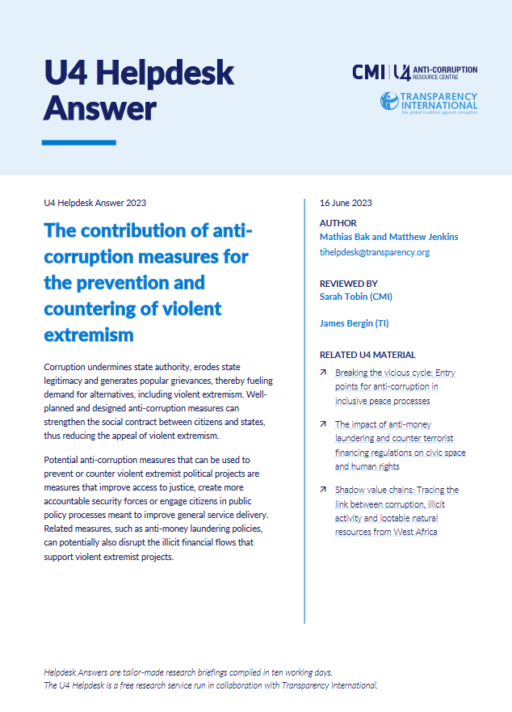- Home
- Anti-Corruption Helpdesk
- The contribution of anti-corruption measures for the prevention and countering of violent extremism
The contribution of anti-corruption measures for the prevention and countering of violent extremism

This Anti-Corruption Helpdesk brief was produced in response to a query from a U4 Partner Agency. The U4 Helpdesk is operated by Transparency International in collaboration with the U4 Anti-Corruption Resource Centre based at the Chr. Michelsen Institute.
Query
Please provide an overview of how anti-corruption measures can contribute to preventing and countering violent extremism (P/CVE).
Summary
Corruption undermines state authority, erodes state legitimacy and generates popular grievances, thereby fueling demand for alternatives, including violent extremism. Well-planned and designed anti-corruption measures can strengthen the social contract between citizens and states, thus reducing the appeal of violent extremism.
Potential anti-corruption measures that can be used to prevent or counter violent extremist political projects are measures that improve access to justice, create more accountable security forces or engage citizens in public policy processes meant to improve general service delivery. Related measures, such as anti-money laundering policies, can potentially also disrupt the illicit financial flows that support violent extremist projects.
Contents
- Corruption as a driver of conflict and violent extremism
- The role of corruption in generating grievances and undermining state legitimacy
- Corruption and popular grievances
- Corruption erodes the social contract
- Corruption as an operational enabler for violent extremist groups
- The role of illicit financial flows
- The role of anti-corruption measures in the prevention and countering of violent extremism
- Anti-corruption measures with the potential to prevent violent extremism
- Programming to strengthen justice and rule of law
- Programming to reduce corruption in service delivery
- Programming to strengthen anti-corruption in security sector reform
- Community engagement approaches
- Anti-corruption measures with the potential to counter violent extremism
- Stamping out corruption in law enforcement agencies and the security forces
- Disrupting the financial and economic networks of extremist groups
- The need for integrating anti-corruption, P/CVE and peacebuilding
- References
Main points
- Efforts to prevent violent extremism must look to provide solutions that tackle the root causes of the phenomenon, including underlying popular grievances that facilitate violent extremists’ recruitment, as well as targeting the symptoms such as acts of violence or insurrection.
- Corruption is a significant grievance that undermines state authority and legitimacy, as well as the social contract between state and citizen.
- Anti-corruption initiatives can strengthen citizenship engagement, accountability and help rebuild trust between authorities and communities.
- Anti-corruption measures designed to reduce violent extremism should address hostility towards state authorities generated by corrupt abuses of power.
Caveat
This paper is the second of a two-part series of Helpdesk Answers on corruption and violent extremism, the first of which examined how violent extremist groups use narratives of corruption to recruit members.
Authors
Mathias Bak and Matthew Jenkins, [email protected]
Reviewers
Sarah Tobin (CMI)
James Bergin (TI)
Date
28/06/2023
Tags
 Download PDF
Download PDF
